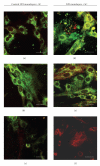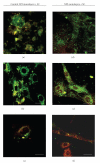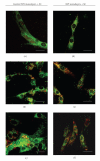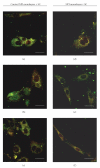Acceleration of functional maturation and differentiation of neonatal porcine islet cell monolayers shortly in vitro cocultured with microencapsulated sertoli cells
- PMID: 21048849
- PMCID: PMC2956457
- DOI: 10.4061/2010/587213
Acceleration of functional maturation and differentiation of neonatal porcine islet cell monolayers shortly in vitro cocultured with microencapsulated sertoli cells
Abstract
The limited availability of cadaveric human donor pancreata as well as the incomplete success of the Edmonton protocol for human islet allografts fasten search for new sources of insulin the producing cells for substitution cell therapy of insulin-dependent diabetes mellitus (T1DM). Starting from isolated neonatal porcine pancreatic islets (NPIs), we have obtained cell monolayers that were exposed to microencapsulated monolayered Sertoli cells (ESCs) for different time periods (7, 14, 21 days). To assess the development of the cocultured cell monolayers, we have studied either endocrine cell phenotype differentiation markers or c-kit, a hematopoietic stem cell marker, has recently been involved with growth and differentiation of β-cell subpopulations in human as well as rodent animal models. ESC which were found to either accelerate maturation and differentiation of the NPIs β-cell phenotype or identify an islet cell subpopulation that was marked positively for c-kit. The insulin/c-kit positive cells might represent a new, still unknown functionally immature β-cell like element in the porcine pancreas. Acceleration of maturation and differentiation of our NPI cell monolayers might generate a potential new opportunity to develop insulin-producing cells that may suite experimental trials for cell therapy of T1DM.
Figures









Similar articles
-
Long-term cultured neonatal porcine islet cell monolayers: a potential tissue source for transplant in diabetes.Xenotransplantation. 2006 Jul;13(4):289-98. doi: 10.1111/j.1399-3089.2006.00305.x. Xenotransplantation. 2006. PMID: 16768722
-
Accelerated functional maturation of isolated neonatal porcine cell clusters: in vitro and in vivo results in NOD mice.Cell Transplant. 2005;14(5):249-61. doi: 10.3727/000000005783983034. Cell Transplant. 2005. PMID: 16052907
-
Functional Maturation and In Vitro Differentiation of Neonatal Porcine Islet Grafts.Transplantation. 2018 Oct;102(10):e413-e423. doi: 10.1097/TP.0000000000002354. Transplantation. 2018. PMID: 29975241
-
Recent progress in porcine islet isolation, culture and engraftment strategies for xenotransplantation.Curr Opin Organ Transplant. 2018 Dec;23(6):633-641. doi: 10.1097/MOT.0000000000000579. Curr Opin Organ Transplant. 2018. PMID: 30247169 Review.
-
Functional maturation of immature β cells: A roadblock for stem cell therapy for type 1 diabetes.World J Stem Cells. 2021 Mar 26;13(3):193-207. doi: 10.4252/wjsc.v13.i3.193. World J Stem Cells. 2021. PMID: 33815669 Free PMC article. Review.
Cited by
-
A brief review of the current status of pig islet xenotransplantation.Front Immunol. 2024 Feb 23;15:1366530. doi: 10.3389/fimmu.2024.1366530. eCollection 2024. Front Immunol. 2024. PMID: 38464515 Free PMC article. Review.
-
Pig-to-Primate Islet Xenotransplantation: Past, Present, and Future.Cell Transplant. 2017 Jun 9;26(6):925-947. doi: 10.3727/096368917X694859. Epub 2017 Feb 3. Cell Transplant. 2017. PMID: 28155815 Free PMC article. Review.
-
A survival Kit for pancreatic beta cells: stem cell factor and c-Kit receptor tyrosine kinase.Diabetologia. 2015 Apr;58(4):654-65. doi: 10.1007/s00125-015-3504-0. Epub 2015 Feb 3. Diabetologia. 2015. PMID: 25643653 Review.
References
-
- Nathan DM. The rationale for glucose control in diabetes mellitus. Endocrinology and Metabolism Clinics of North America. 1992;21(2):221–235. - PubMed
-
- Shapiro AMJ, Ricordi C, Hering BJ, et al. International trial of the Edmonton protocol for islet transplantation. The New England Journal of Medicine. 2006;355(13):1318–1330. - PubMed
-
- Luca G, Nastruzzi C, Calvitti M, et al. Accelerated functional maturation of isolated neonatal porcine cell clusters: in vitro and in vivo post-transplant results in NOD mice. Cell Tranplantation. 2005;14:249–261. - PubMed
LinkOut - more resources
Full Text Sources

